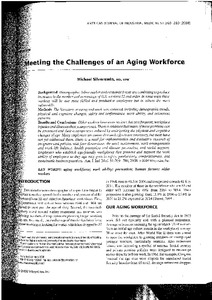Meeting the challenges of an aging workforce

American Journal of Industrial Medicine
2008
51
4
April
269-280
employability ; human factors ; older worker ; prevention
Older people
English
Bibliogr.
"Background Demographic, labor market and economic forces are combining to produce increases in the number and percentage of U.S. workers 55 and older. In some ways these workers will be our most skilled and productive employees but in others the most vulnerable. Methods The literature on aging and work was reviewed, including demographic trends, physical and cognitive changes, safety and performance, work ability, and retirement patterns. Results and Conclusions Older workers have more serious, but less frequent, workplace injuries and illnesses than younger ones. There is evidence that many of these problems can be prevented and their consequences reduced by anticipating the physical and cognitive changes of age. Many employers are aware that such efforts are necessary, but most have not yet addressed them. There is a need for implementation and evaluative research of programs and policies with four dimensions: the work environment, work arrangements and work-life balance, health promotion and disease prevention, and social support. Employers who establish age-friendly workplaces that promote and support the work ability of employees as they age may gain in safety, productivity, competitiveness, and sustainable business practices. "
Digital
The ETUI is co-funded by the European Union. Views and opinions expressed are however those of the author(s) only and do not necessarily reflect those of the European Union or the ETUI.